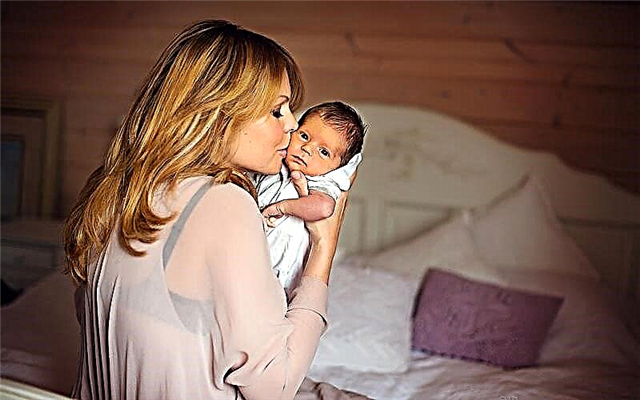If parents notice traces of blood in their baby's stool during a diaper change, it will be natural for them to worry about this. They should be aware that there are various reasons that can cause blood during bowel movements in a child, not all of them are associated with serious health problems.

Potty baby
Important! In any case, if blood is found in the child's diaper after bowel movement, it is necessary to contact a pediatrician who will assess the cause and prescribe treatment or recommend a change in habits.
Causes of blood during bowel movements
The presence of blood in the stool of infants can be a worrying sign, but doctors advise not to assume the worst right away. Red stools are associated with certain foods. If the mother noticed a red tint in the stool, she should think about what the baby recently ate, and subsequently observe him. However, pathological processes cannot be ruled out.
Crohn's disease
It is a chronic inflammatory pathology of autoimmune origin that can affect any part of the digestive system, from the mouth to the anus. Most often this occurs in the end of the small intestine or at the beginning of the colon.

Crohn's disease
Additional symptoms:
- abdominal pain;
- diarrhea or constipation (mucus and blood may or may not be present in the stool);
- cracks and ulcers;
- high temperature;
- lack of appetite and weight loss;
- general malaise and weakness.
Important! Crohn's disease is extremely rare in preschool children.
Lactase deficiency
With lactase deficiency, the baby does not have an enzyme that breaks down milk sugar - lactose. In infants, this condition often goes away after a while without any treatment.
A possible cause of a lack of lactase may be excess milk given to the baby. His body is unable to digest milk completely.
Hemorrhoids
Blood from the priests of a child may appear in the presence of hemorrhoids. Although this disease usually affects adults, it also occurs in an infant under one year old.
Hemorrhoids can be seen in the anus. They often cause discomfort: pain and burning sensation in the anus.
The reasons for the development of hemorrhoids in infants are a genetic predisposition, frequent constipation. Sometimes the disease is asymptomatic.
Anal fissure and allergies
An anal fissure is characterized by a small tear in the lining of the anus or rectum, in most cases due to constipation. It is the most common cause of blood after a bowel movement in a child. This should not cause much concern, however, if it is repeated, measures should be taken to soften the stool.

Anal fissure
Blood in the stool can also be a symptom of a cow's milk protein allergy. It is more common in infants who are bottle-fed. However, if a nursing mother consumes a lot of milk and dairy products, then the child may also develop allergies.
Bowel obstruction
This is a dangerous condition that threatens the life of the baby. It can be both congenital and subsequently developed. It is often treated only surgically.
The causes of pathology are intestinal intussusception, when one part of it slides into another: these are the consequences of operations; hernias and tumors; infections.
It is manifested by symptoms:
- bloating and sharp pains (while gas does not go away);
- vomiting with bile;
- feces come out in small quantities, often with blood, sometimes there is none at all.
Other factors
The reasons for the appearance of blood during the bowel movement of the baby are less often different:
- The presence of a polyp. Benign growths may appear in the intestines and bleed;

Intestinal polyp
- Colitis is an inflammation of the colon, often caused by bacteria. Its main symptoms are diarrhea, abdominal pain, fever;
- Meckel's diverticulum. It is a small sac, or lump, that forms in the wall of the small intestine. It happens that he is already present at birth. Usually there are no symptoms, but rectal bleeding sometimes occurs;
- Congenital defect in the blood vessels of the intestine. Usually must be diagnosed at birth;
- Cracked mother's nipples. When breastfeeding, your baby may swallow blood from bleeding nipples. Then, when he defecates, the feces change in appearance;
- Diaper rash. The baby's skin is very delicate and the diaper area is always wet. This can cause bleeding irritations. In this case, the child's blood after stool appears from a wound on the skin.
Important! For skin irritations, it is best to avoid cleansing the anus with toilet paper and tissues. You just need to rinse the anal area with water using cotton or gauze.
The opinion of Dr. Komarovsky
Pediatrician E. Komarovsky advises parents to first remember what product or drug was given to the baby the day before, since the feces can be colored red without the presence of blood in it. Stool discoloration is caused, for example, by taking antibiotics, eating beets and foods high in iron.
The most common causes of blood in a baby's feces, in his opinion, are anal fissures and allergic reactions to milk proteins. However, sometimes the child's condition inspires serious concern, and only a doctor can make an accurate diagnosis. Therefore, do not postpone a visit to the pediatrician.
Diagnostic methods
Important! If the blood from the child's anus appears scarlet, drops, remains on toilet paper after wiping, this, as a rule, indicates anal fissures or hemorrhoids.
The presence of dark bloody blotches and streaks in the stool indicates problems in the upper intestine. In this case, procedures and examinations are prescribed to clarify the diagnosis.
Diagnostic methods:
- feces analysis (for occult blood, coprogram, etc.);
- rectal palpation;
- Ultrasound;
- endoscopic examination - sigmoidoscopy;

Sigmoidoscopy for a child
- fibrogastroduodenoscopy (FGDS) - examination of the digestive system using fiber optics.
When you urgently need to see a doctor
Experts assure that a small amount of blood after the act of bowel movement in the baby's feces is not a problem, especially if it happened once, and there are no symptoms of the child's poor condition.
The following additional symptoms require an immediate call to a doctor:
- the presence of diarrhea with bile (green streaks in the stool);
- vomiting blood;
- high body temperature;
- stomach hurts badly;
- for several days the baby does not defecate;
- persistent bleeding.
Preventive measures
If the reason for the appearance of blood in the stool is that the child began to hurt, then after the diagnosis is made, he will need appropriate treatment. It is often urgent and in a hospital setting.
In cases of light bleeding, that is, if the child is stable, he does not have anemia, and blood in the stool occurs once or very rarely, the baby must be monitored. Preventive measures to prevent re-bleeding:
- If you are allergic to cow's milk proteins, a nursing mother should stop using it, just as it should not be given to babies to drink;
- For normal functioning of the baby's gastrointestinal tract, it is better to feed him with breast milk. Adapted mixtures sometimes cause constipation, which leads to the formation of anal fissures;
- It is necessary to check the condition of the anus and the skin around it from time to time for sores or inflammation.
Adults often unambiguously associate blood in the feces of children with the disease. However, a small amount in stool does not always indicate a health problem. On the other hand, alarming symptoms should not be underestimated and it is better to consult a pediatrician about this.



